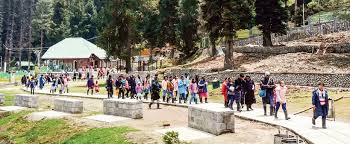Kashmir just saw its hottest June in almost 5 decades

Srinagar, July 2 — Kashmir Valley is reeling under an unprecedented heatwave as it recorded its hottest June in nearly five decades, leaving meteorologists alarmed and residents struggling to cope with the searing temperatures. According to the India Meteorological Department (IMD), June 2025 saw average maximum temperatures in many parts of the Valley hovering around 35°C — a stark deviation from the region’s historical June average of 28–30°C.
Unusual Heat Disrupts Traditional Weather Patterns
The capital city of Srinagar clocked its highest June temperature in over 48 years on multiple days, with the mercury breaching 35.6°C on June 24. Officials say the last time such extreme heat was recorded in the region during June was back in 1977.
“What we are witnessing is not just a regular summer spike — this is a prolonged heat anomaly,” said Dr. Mukhtar Ahmad, Director of Meteorological Centre, Srinagar. “June this year broke several heat records across Kashmir. Such sustained high temperatures are rare in the Valley’s climate history.”
Low Rainfall Aggravates the Heat
Meteorologists attribute the intense heat to a combination of factors — most notably, an unusual deficit in pre-monsoon rainfall. The IMD reported that Kashmir saw 60% less rainfall than the seasonal average in June. The lack of precipitation allowed daytime temperatures to rise unchecked while offering little nighttime respite.
“Pre-monsoon showers usually keep the Valley cooler during June, but this year, persistent dry weather and intense solar radiation amplified the heat,” added Dr. Ahmad.
Glaciers, Agriculture, and Livelihoods Under Threat
The spike in temperature has triggered concern over the accelerated melting of Himalayan glaciers that feed Kashmir’s rivers. Environmentalists warn that the heat could disturb the region’s delicate ecosystem and water balance.
“Glaciers in upper Kashmir have started melting earlier than usual. This has immediate implications for water availability during late summer and autumn,” said Nazir Sheikh, a hydrologist working with a local environmental NGO. “We’re also worried about the potential for flash floods if the current heat continues.”
The agricultural sector is equally impacted. Apple orchards, saffron farms, and paddy fields are experiencing stress due to both heat and water scarcity. Farmers in Pulwama and Baramulla districts report stunted crop growth and increased irrigation demands.
“Our apple trees are shedding leaves early, and the fruits are smaller than normal,” said Abdul Rashid, a farmer from Shopian. “This summer heat is unlike anything we’ve dealt with in recent memory.”
Public Health Concerns Mount
Hospitals across the Valley have witnessed a sharp rise in heat-related ailments. Doctors report an increase in cases of dehydration, heatstroke, and skin rashes, especially among older people and children.
“The lack of cool nights is a major concern. Kashmiris are not physiologically adapted to such high temperatures,” said Dr. Saima Yousuf, a public health expert. “We’re advising people to stay indoors during peak hours and hydrate regularly.”
With many homes in Kashmir traditionally built for cold weather, there’s limited access to fans or air conditioning, particularly in rural areas. Residents are using makeshift methods like damp cloths, cold baths, and shaded spaces to beat the heat.
Tourism Sees Mixed Impact
Interestingly, while the heat has caused discomfort for locals, it has drawn tourists from other parts of India seeking to escape even higher temperatures in the plains. Hill stations like Pahalgam, Gulmarg, and Sonamarg saw a spike in visitors in late June, even as locals struggled with heat stress.
However, tourism operators warn that sustained heat could alter travel patterns. “If the trend continues, people might avoid Kashmir in peak summer and opt for cooler regions like Ladakh,” said Zahoor Mir, a hotel owner in Gulmarg.
Climate Change the Root Cause?
Experts are pointing to climate change as a primary factor behind Kashmir’s extreme weather shift. While occasional heatwaves are natural, the increasing frequency and intensity of such events suggest deeper systemic changes.
“This is not an isolated incident. Over the past decade, we’ve observed warmer winters, erratic spring rainfall, and now hotter summers,” said Dr. Sameera Lone, a climate researcher at the University of Kashmir. “These trends align with global climate models predicting higher temperatures in the Himalayan region.”
According to a recent study by the Intergovernmental Panel on Climate Change (IPCC), the Himalayan region is warming at a rate faster than the global average — a fact that poses grave risks for both ecology and human settlements.
Urgent Need for Preparedness and Adaptation
The current heatwave has sparked calls for improved weather forecasting, better infrastructure, and a robust climate adaptation policy for Kashmir.
“Authorities need to invest in heat-resilient housing, early warning systems, and drought management plans,” said Mohammad Yasin, a disaster management officer. “Ignoring these signs can lead to bigger crises, especially in ecologically fragile zones like ours.”
In the short term, the administration has advised schools to adjust timings, increased water supply in urban areas, and issued public health advisories.






